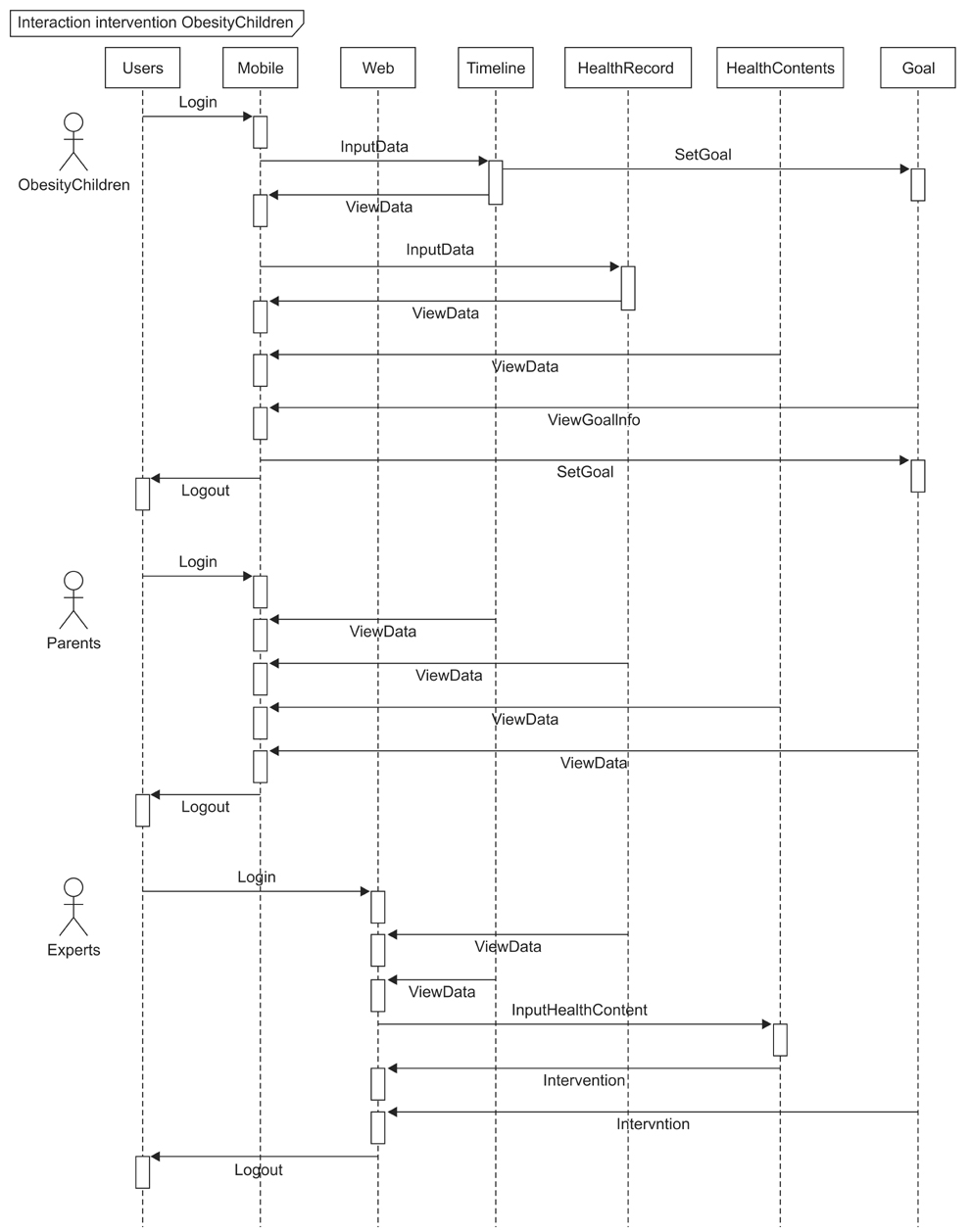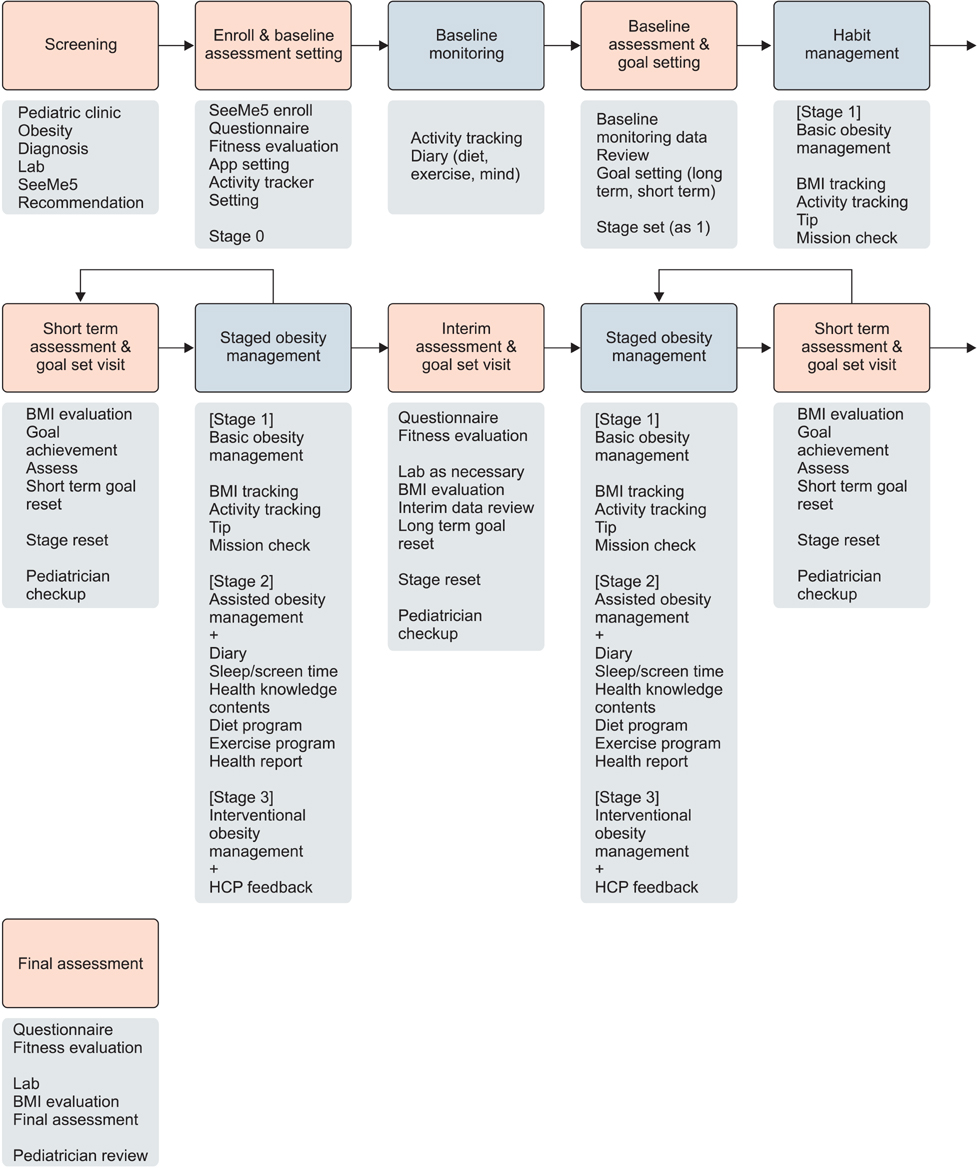Healthc Inform Res.
2016 Jul;22(3):243-249. 10.4258/hir.2016.22.3.243.
Development of Child-Teen Obesity Treatment Service Platform
- Affiliations
-
- 1Department of IT Convergence Engineering, Gachon University, Seongnam, Korea.
- 2Department of Computer Engineering, Gachon University, Seongnam, Korea. lyh@gachon.ac.kr
- KMID: 2357403
- DOI: http://doi.org/10.4258/hir.2016.22.3.243
Abstract
OBJECTIVES
This study aimed to develop an effective and efficient obesity treatment and management service platform for obese children/teenagers.
METHODS
The integrated smart platform was planned and established through cooperation with service providers such as hospitals and public health centers, obese children/teenagers who constitute the service's user base, and IT development and policy institutions and companies focusing on child-teen obesity management and treatment.
RESULTS
Based on guidelines on intervention strategies to manage child-teen obesity, we developed two patient/parent mobile applications, one web-monitoring service for medical staff, one mobile application for food-craving endurance, and one mobile application for medical examinations.
CONCLUSIONS
The establishment of the integrated service platform was successfully completed; however, this study was restrictively to the hospital where the pilot program took place. The effectiveness of the proposed platform will be verified in the future in tests involving other organizations.
Keyword
MeSH Terms
Figure
Reference
-
1. Lee NY, Yoo SH, Lee S, Kwon O. U-healthcare service for psychological wellbeing lifecare. Korean J Bus Adm. 2012; 25(8):3397–3415.2. Korea Ministry of Health and Welfare. A plan for child protection policy [Internet]. Sejong: Ministry of Health and Welfare;2015. cited at 2016 Mar 1. Available from: http://www.mohw.go.kr/front_new/al/sal0301vw.jsp?PAR_MENU_ID=04&MENU_ID=0403&BOARD_ID=140&BOARD_FLAG=00&CONT_SEQ=322332&page=1.3. Korean Society for the Study of Obesity. Clinical practice guidelines for overweight and obesity in Korea 2014 [Internet]. Seoul: Korean Society for the Study of Obesity;2015. cited 2016 Mar 1. Available from: http://www.kosso.or.kr/eng/.4. Kim H, Cho J, Kim S, Kang Y. Child/teenager obesity prediction research [Internet]. Seoul: Korea Institute for Health and Social Affairs;2015. cited at 2016 Feb 20. Available from: https://research.khealth.or.kr/hpResearch/rsfileTde.dia?method=reportfile&rs_idx=961&rs_code=1502001.5. Yu G, Park J. Types of studies on smart media contents for ubiquitous health service. J Korea Des Knowl. 2013; 28:195–202.6. Jeon E, Park HA. Development of a smartphone application for clinical-guideline-based obesity management. Healthc Inform Res. 2015; 21(1):10–20.
Article7. Jeon E, Park HA. Factors affecting acceptance of smartphone application for management of obesity. Healthc Inform Res. 2015; 21(2):74–82.
Article8. Jeon E, Park HA, Min YH, Kim HY. Analysis of the information quality of Korean obesity-management smartphone applications. Healthc Inform Res. 2014; 20(1):23–29.
Article9. SeeMe5 [Internet]. Seoul: SeeMe5;2015. cited at 2016 Feb 22. Available from: http://www.seeme5.org/.10. National Health Information Portal. Childhood obesity [Internet]. Sejong: Ministry of Health and Welfare;2015. cited at 2016 Feb 12. Available from: http://health.mw.go.kr/HealthInfoArea/HealthInfo/View.do?idx=3450.
- Full Text Links
- Actions
-
Cited
- CITED
-
- Close
- Share
- Similar articles
-
- Design of service delivery for a child obesity prevention and management program using technology convergence
- Phthalate exposure and childhood obesity
- A Review of Childhood Obesity
- A Study for the Model Development of 'Child Health Management Program'
- Development of a home health care service platform for ostomy patient management





